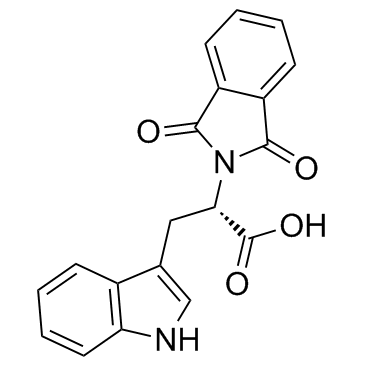RG108

RG108 structure
|
Common Name | RG108 | ||
|---|---|---|---|---|
| CAS Number | 48208-26-0 | Molecular Weight | 334.326 | |
| Density | 1.5±0.1 g/cm3 | Boiling Point | 606.0±50.0 °C at 760 mmHg | |
| Molecular Formula | C19H14N2O4 | Melting Point | 192-194℃ | |
| MSDS | USA | Flash Point | 320.3±30.1 °C | |
|
Inhibition of DNA methyltransferase as a novel therapeutic strategy to overcome acquired resistance to dual PI3K/mTOR inhibitors.
Oncotarget 6(7) , 5134-46, (2015) Dual PI3K/mTOR(phosphatidylinositol 3-kinase/mammalian target of rapamycin) inhibitors are being evaluated clinically for the treatment of tumors with a hyperactivated PI3K/mTOR pathway. However, unexpected outcomes were obtained in clinical studies of cancer... |
|
|
c-ETS transcription factors play an essential role in the licensing of human MCM4 origin of replication.
Biochim. Biophys. Acta 1849 , 1319-28, (2015) In metazoans, DNA replication is a highly regulated and ordered process that occurs during the S phase of cell cycle. It begins with the licensing of origins of replication usually found in close proximity of actively transcribing genes owing perhaps to a pro... |
|
|
DNA methyltransferase DNMT3A associates with viral proteins and impacts HSV-1 infection.
Proteomics 15 , 1968-82, (2015) Viral infections can alter the cellular epigenetic landscape, through modulation of either DNA methylation profiles or chromatin remodeling enzymes and histone modifications. These changes can act to promote viral replication or host defense. Herpes simplex v... |
|
|
Dnmts and Tet target memory-associated genes after appetitive olfactory training in honey bees.
Sci. Rep. 5 , 16223, (2015) DNA methylation and demethylation are epigenetic mechanisms involved in memory formation. In honey bees DNA methyltransferase (Dnmt) function is necessary for long-term memory to be stimulus specific (i.e. to reduce generalization). So far, however, it remain... |
|
|
Differences in the Epigenetic Regulation of Cytochrome P450 Genes between Human Embryonic Stem Cell-Derived Hepatocytes and Primary Hepatocytes.
PLoS ONE 10 , e0132992, (2015) Human pluripotent stem cell-derived hepatocytes have the potential to provide in vitro model systems for drug discovery and hepatotoxicity testing. However, these cells are currently unsuitable for drug toxicity and efficacy testing because of their limited e... |
|
|
Epigenetic Regulation of Dopamine Transporter mRNA Expression in Human Neuroblastoma Cells.
Neurochem. Res. 40 , 1372-8, (2015) The dopamine transporter (DAT) is a key regulator of dopaminergic neurotransmission. As such, proper regulation of DAT expression is important to maintain homeostasis, and disruption of DAT expression can lead to neurobehavioral dysfunction. Based on genomic ... |
|
|
Non-genetic direct reprogramming and biomimetic platforms in a preliminary study for adipose-derived stem cells into corneal endothelia-like cells.
PLoS ONE 9(10) , e109856, (2014) Cell fate and function can be regulated and reprogrammed by intrinsic genetic program, extrinsic factors and niche microenvironment. Direct reprogramming has shown many advantages in the field of cellular reprogramming. Here we tried the possibility to genera... |
|
|
Experience-dependent DNA methylation regulates plasticity in the developing visual cortex.
Nat. Neurosci. 18 , 956-8, (2015) DNA methylation is an epigenetic repressor mark for transcription dynamically regulated in neurons. We analyzed visual experience regulation of DNA methylation in mice and its involvement in ocular dominance plasticity of the developing visual cortex. Monocul... |
|
|
Global DNA methylation changes and differential gene expression in Anaplasma phagocytophilum-infected human neutrophils.
Clin. Epigenetics. 7 , 77, (2015) Anaplasma phagocytophilum is an obligate intracellular prokaryotic pathogen that both infects and replicates within human neutrophils. The bacterium represses multiple antimicrobial functions while simultaneously increasing proinflammatory functions by reprog... |
|
|
Methylation-dependent loss of RIP3 expression in cancer represses programmed necrosis in response to chemotherapeutics.
Cell Res. 25 , 707-25, (2015) Receptor-interacting protein kinase-3 (RIP3 or RIPK3) is an essential part of the cellular machinery that executes "programmed" or "regulated" necrosis. Here we show that programmed necrosis is activated in response to many chemotherapeutic agents and contrib... |